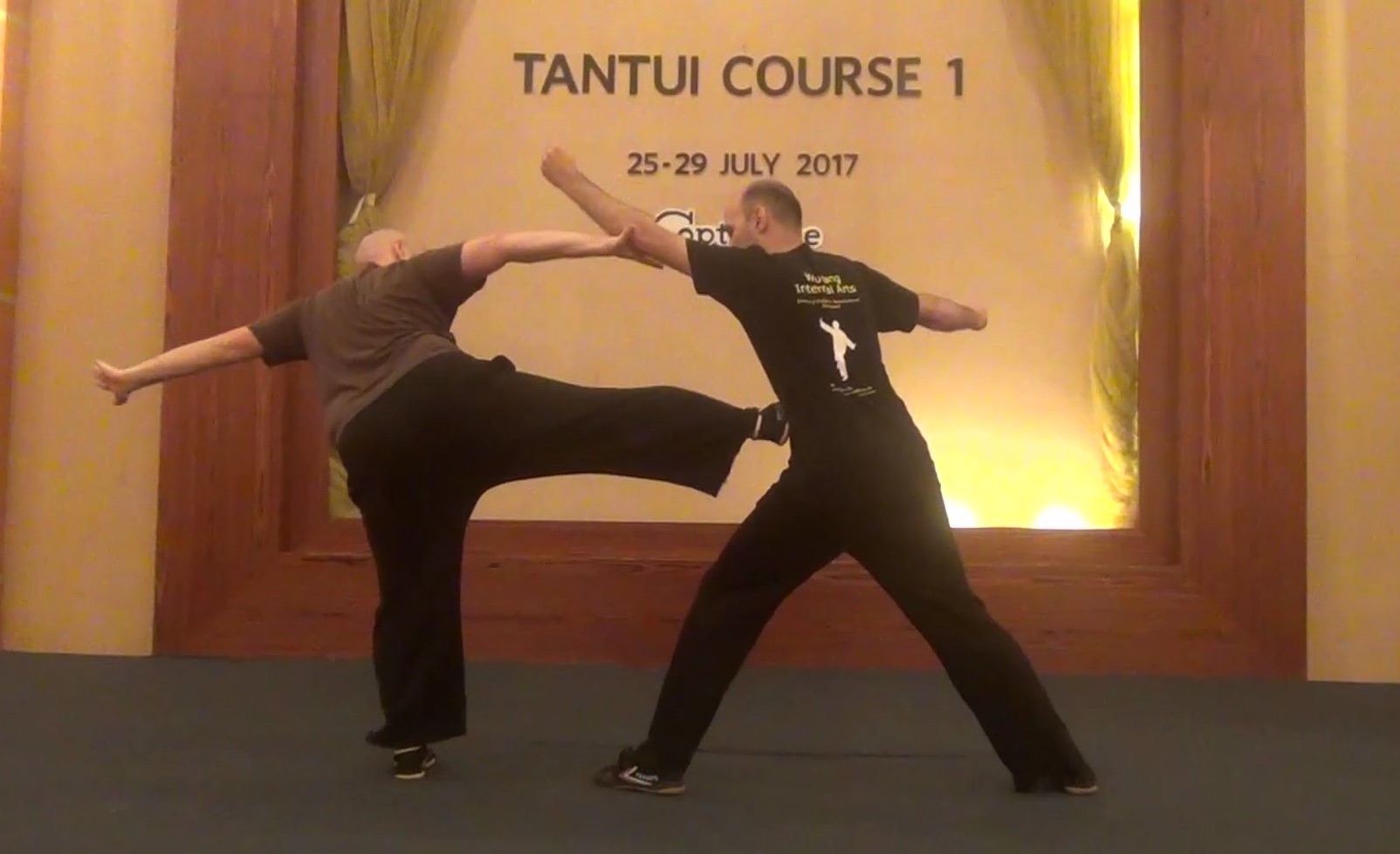NAN QUAN BEI TUI, OR SOUTHERN FISTS NORTHERN KICKS

Pierre, employing Tantui of Northern Shaolin, executed a side-kick at Sifu Hubert
Question
In one of your writings, Sifu once wrote:
-
The saying “nan quan bei tui”, or “Southern Fists Northern Kicks”, typically sums up the main difference between Southern Shaolin Kungfu and Northern Shaolin Kungfu. Southern Shaolin styles are well known for fists, whereas Northern Shaolin styles are well known for kicks...
... So another typical difference, besides the use of fists and kicks, is the Northern Shaolin styles are agile and involve a lot of wide movement and open space, whereas Southern Shaolin styles are solid with narrower movement and less space. Many commentators mention that this typical difference is due to the availability of wide, open ground in north China, and crowded narrow lanes in the south.
May Sifu share with us what would the best strategies/patterns/skills/styles be when involved in a multi-opponent fight in a wide and open space? How about in a narrow and closed space?
-- Santiago
Answer
“Nan quan bei tui”, or “Southern Fists Northern Kicks”, is traditionally used to describe the difference between Southern Shaolin Kungfu and Northern Shaolin Kungfu, and sometimes between southern styles of kungfu and northern styles as there are other kungfu styles besides Southern Shaolin and Northern Shaolin.
This saying, however, is not universal. There were masters of southern styles who were specialized in kicks, like Fong Sai Yoke and Wong Fei Hoong, and northern masters who specialized in using their hands, like the Taijiquan master, Yang Lu Chan, who specialized in “Grasping Sparrow’s Tail” and the Xingyiquan master, Gua Yun Shen, whose “half a step of crushing fist beats heaven and earth”.
In a multi-opponent fight, it is the skill of the master that counts, not the kungfu style he practices. If the master is skilful, he can escape any ambush irrespective of the style he practices. If he knows the principles and techniques, like what will be taught in our Becoming a Shaolin Wahnam Kungfu Practitioner course, it will be better.
Nevertheless, certain kungfu styles are more conducive to mass fighting. Choy-Li-Fatt Kungfu and Wing Choon Kungfu are a good contrast. While Choy-Li-Fatt Kungfu is more suitable against multiple opponents, Wing Choon Kungfu is more suitable for masters in solo combat. However, if the masters are skilful and knowledgeable, the Wing Choon master can be good at multiple fighting, and the Choy-Li-Fatt master can be good at advanced solo combat.
The strategies, patterns and skills that are suitable for multi-opponent fights in wide and open space involve continuously moving about among opponents, like Drunken Eight Immortal Kungfu, movements with wide stances and far-stretching arms, like “Lohan Emerges from Cave”, and talents that focus on mobility and agility.
On the other hand, strategies, patterns and skills that are suitable for fighting in narrow and closed space involve staying quite stationary at one place, like Chow Ka Kungfu, movements with narrow stances and close-body arms, like “Night Tiger Comes out of Forest”, and abilities that focus on solidness and power.
Such division, however, is not always true, and there are many examples in kungfu history to illustrate it.
Lu Sai Leong, a lady kungfu master, for example, single-handedly fought her way through thousands of imperial guards into the palace to assassinate the Emperor Yung Cheng, who himself was a kungfu master wearing an impenetrable vest, to avenge for the burning of the Shaolin Monastery. It was reputed that Lu Sai Leong later became the famous Ng Mui.
Lu Sai Leong was a master of Southern Shaolin, known for powerful, stationary combat, but her fighting through thousands of imperial guards suggested that she must have used a lot of agile movement.
In more recent times, a kungfu master called Crazy Khun, who was a contemporary of my sifu, Uncle Righteousness, fought his way using a towel from an ambush to kill him at the New Life Plaza in Penang in the early 1900s. Crazy Khun was a Southern Shaolin master, but he must have employed a lot of agile movement in his fight.
My siheng, Ang Teng, from Sifu Ho Fatt Nam’s lineage, was a specialist of the Monkey style, which belongs to Northern Shaolin, known for agility and movement. He became well known because of a fight against many attackers. He used the tactic of “back-wall battle”, which would be more suited to narrow lanes of closed environment, and fought off all his attackers.
Hence, although “nan quan bei tui”, or “Southern Fists Northern Kicks”, is a popular saying, it is the skills and knowledge of the master that counts in multi-opponent combat. We shall learn these skills and knowledge in the coming “Becoming a Shaolin Wahnam Kungfu Practitioner” course.
The questions and answers are reproduced from the thread 10 Questions on "Becoming a Shaolin Wahnam Kungfu Practitioner" in the Shaolin Wahnam Discussion Forum.
LINKS
